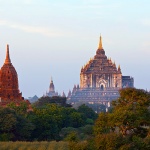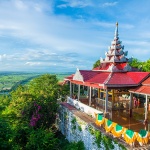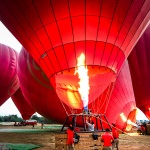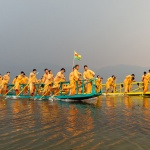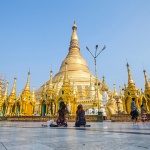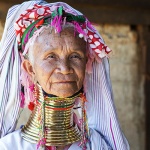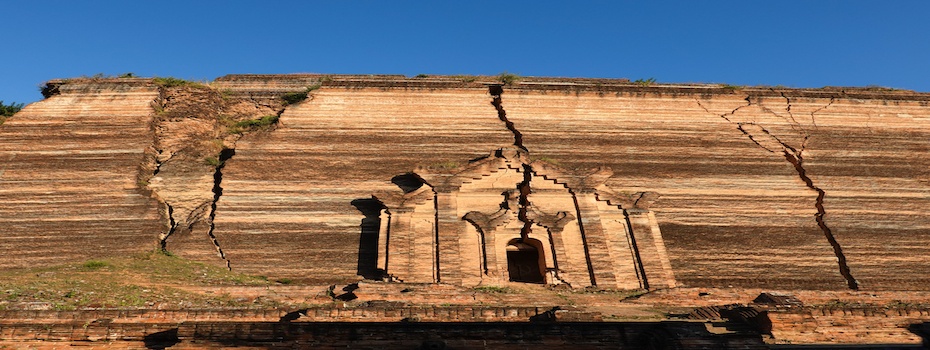Heading the Ancient of Myanmar
By Carol Rudy
The ancient cities of Myanmar have long been a cultural attraction with their ancient temples and ruins that mark the rise and fall of kingdoms that once flourished. Some of them date as far back A 200BC and it is a true wonder to stand among the ruins of a once great city and marvel at the structures that have withstood the test of time.
Traditional Capitals
In Myanmar’s long history, capitals were moved several times for various reasons. For example King Mindon moved the capital from Amarapura to Mandalay to fulfil a Buddhist prophecy. The entire process of moving a capital was not easy, as the buildings had to be dismantled and transported – the most important monasteries would be rebuilt later on.
Sagaing
The Sagaing empire was governed by Shan kings from 1315 to 1364 and rests on the west bank of the Ayeyarwady River. It has a large number of pagodas and monasteries, with the U Min Thonze Pagoda a well-known structure for its 45 large Buddha images that are arranged in a crescent. On top of Sagaing Hill is Kaungmudaw Pagoda, built in 1636 as one of the largest stupas in Myanmar. Due to warring Shan kingdoms, the empire collapsed in 1364.
Innwa
Innwa was also called Ava, and served as the capital of Myanmar during five separate occasions, the first being from 1365 to 1555 during the Ava Kingdom. The kingdom had several successful rulers between the 14th century to the 19th century and was occasionally rebuilt. However, most of the city was destroyed during a great earthquake in 1839. The remains of the Royal Palace today is a tilting watch tower and moat, and protective walls that surround the palace. The most noticeable landmark is the Brick Monastery, which is an elaborately decorated building with brick walls. The most impressive, though, is Bagaya Monastery. It was built in 1834 and today it serves as a school for monks.
Amarapura
South of Mandalay is Amarapura, which was founded by King Bodawpaya in 1783. It became the capital of Myanmar during the Konbaung Dynasty for 38 years, before being replaced by Innwa. It was slated as capital again from 1841 to 1857 until King Mindon moved the capital to Mandalay. The U Bein Bridge was built here in the 19th century using the leftover wood from dismantling the other buildings, and is 1,200 metres long. The other monasteries that are worth a visit in Amarapura are Pahtodawgyi Pagoda, built in the 10th century and Shwe Gu Gyi Pagoda, built in the 12th century.
Today, Amarapura is known for its silk industry, so you can visit a silk-weaving workshop to watch craftsmen at work. You can also visit Mahagandayon Monastery on the way, as it is one of Myanmar’s largest teaching monasteries.
Past Dwellings
Bagan is an ancient city that once thrived from the 11th to the 13th century, during a time where Bagan was the capital of the first Myanmar empire. Located on the banks of Ayeyarwady River, this city was once home to a civilisation that dwelled in the 13,000 brick temples that lay scattered throughout the land. The entire area is known as ‘Old Bagan’, and 2,300 temples can be visited today in the Bagan Archaeological Zone.
Over the centuries, the structures have endured strong winds, floods, and human vandalism, yet most of the city’s stone infrastructure is still standing today. All of the temples and pagodas of Bagan are UNESCO-certified, and these hold a lot of religious value to the local people.
In this dry, dusty expanse of land, it is not just the erected monuments that people flock from all over the world to see. The sunrise, when viewed from the upper decks of a Bagan temple, is simply mesmerising. You will catch the view of the temples spread from below, seemingly glittering as the first rays of the sun break through. In fact, a popular attraction for sunrise-viewing is from the hot air balloons, which presents a surreal view of the entire city from high above, as you view the pagoda’s peaks jutting out from the trees and watch the sky come to life.
The Shwezigon Pagoda is one of the oldest and most impressive monuments of Bagan, which dons 30,000 copper plates that glimmer in the sun. Several smaller shrines have been added to the pagoda after restoration work was done due to an earthquake in 1975. Pilgrims and devotees come from all over the country to pay respect and celebrate the Shwezigon Festival, held during the 9th month of the Myanmar calendar. At night, the pagoda is illuminated by spotlights that give it a mystical aura. Surrounded by the quiet solitude of the dark and deserted temples, Shwezigon Pagoda gives visitors an exceptional experience in exploring the culture of Bagan.
Ananda Temple is one of Bagan’s best-preserved temples, built using influence from Mon and Indian architecture and was completed in 1105AD. The most distinctive feature of the temple is its gilded spire, placed on top of the pagoda and visible from miles away. If viewed from above during sunrise, it is a spectacular sight as it reflects sunlight across the dry plains, enhanced by the backdrop of the rising sun.
A legend arose regarding the founding of the temple where eight monks arrived at the palace one day, begging for alms. King Kyanzittha granted them an audience and they told him about a legendary cave temple they saw in the Himalayas. They used their powers to create a vision of the temple’s snowy landscape to the king. He was so impressed that he decided to replicate the temple he saw in their vision right in Bagan. After the Ananda Temple was completed, he had the architects executed so that they could not replicate the design elsewhere.
Old, But Not Forgotten
The three Pyu ancient cities of Halin, Beikthano and Sri Kestra have been recognised as UNESCO world heritage sites since 2014. These are Pyu Kingdoms that flourished for more than 1,000 years between 200BC to 900AD and the remains today are some of the world’s oldest Buddhist monuments. These include palace citadels, burial grounds, and water management systems that are still in use today, evidence of the innovation and adequacy of civilisations past.
These cities were enclosed with external brick walls, and the interior consisted of manmade gardens, lakes, moats, residential housing, Buddhist monuments and a well-guarded palace at the centre. The palace had several guard posts, thus the city was planned to be self-sufficient to withstand enemy attacks. The Pyu also demonstrated their own adaptability with water control, brickmaking and ironwork. Three magnificent stupas of the city, Payama, Payagyi and Bawbawgyi are in intact condition and bear witness to the spread of Buddhism in Myanmar’s early kingdoms. However, the fall of the Pyu kingdom approached when an army from Nanzhao kidnapped 3,000 citizens, and the remaining people were assumed to blend in with the rest of society.
In the present, there are excavations of red-brick city walls, gateway entrances and stupa bases for visitors to see. Artefacts of the Pyu kingdom can be viewed at the museum, displaying jewellery, coins, and tools of the era.

